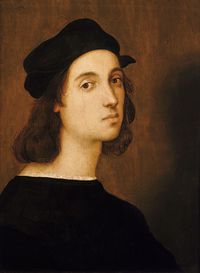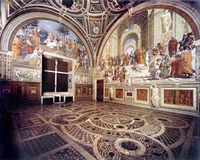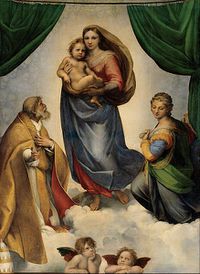What was Raphael's contribution to the Renaissance
The Italian Renaissance left an enduring artistic legacy. Traditionally, the three great master painters of the era are regarded as Michelangelo, Leonardo, and Raphael. Raffaello Sanzio da Urbino (1483-1517), better known as Raphael, is often cited as one of the greatest and most influential painters of all time. He was not only a great artist who produced great works but made a real contribution to the Renaissance, in several areas.
Raphael’s work was revolutionary, and he changed the history of art in this epoch both in Italy and beyond. Indeed, he inspired new artistic schools. He was a Renaissance man and a pioneer in printmaking. Raphael was one of the first artists to use this medium. Moreover, he was crucial in the emergence of the modern conception of the artist.
Life and times of Raphael
Raphael was born on April 6, 1483, in Urbino, Italy. At this time, Urbino was a small dukedom in the Papal States and one of the centers of the Renaissance. His father was Giovanni Santi, who was the court painter for the Duke of Urbino. It appears that Raphael’s father taught him the basics of painting at an early age. His childhood was idyllic, but his mother died when he was eight and his father died when he was just eleven. Remarkably, while still a child it is claimed that he took over his father’s workshop and he became an accomplished painter.[1]
This story may be apocryphal, because Raphael was later apprenticed to the well-known painter Perugino, in Umbria. While serving his apprenticeship, he worked on frescoes and learned new techniques. Raphael soon developed his unique style, as seen in the Oddi Altar place, completed in 1503. From an early age, he was committed to demonstrating the grandeur of humanity, probably under the influence of Neoplatonism.
After completing his apprenticeship, the young painter moved to Florence, where he studied the works of Leonardo and others. He composed a series of paintings on the Madonna (Virgin Mary), and this made him famous. He attracted the attention of Pope Julius II, who commissioned him to paint the Vatican ‘Stanze,’ a suite of reception rooms in the Papal Palace. Raphael painted several massive frescoes, among the most famous of these is the School of Athens, a painting of the great ancient Greek philosophers. He labored for over four years to create a cycle of frescoes that include the Triumph of Religion.
These images express the Christian humanist philosophy that was prevalent in Rome at the time. These paintings were very well-received, and the Pope commissioned another set of frescoes for the Room of Heliodorus. These works are considered among the greatest works of the High Renaissance. At the same time, Michelangelo was painting the Sistine Chapel, and he came to dislike the younger painter. He began to suspect that Raphael was conspiring with others against him. Michelangelo accused the young man from Urbino of plagiarising his work, but no one took this seriously.[2]
While working on the Vatican Rooms, Raphael established a workshop where he and his assistants produced numerous paintings of the Virgin Mary, including the renowned Sistine Madonna (1512). He also painted many notable portraits at the time, including that of Pope Julius II and two cardinals (1519) and the astounding character study of the writer Baldassare Castiglione (1516). Raphael was a tireless worker, and he also produced many great cartoons, and he is regarded as one of the greatest draughtsmen in all western art.
Raphael, like the other significant Renaissance figures, was a man of many talents, and he was also an architect. Raphael had great respect for the classical past, and he was one of the first to display an interest in archaeology. He urged the Pope to stop the destruction of ancient ruins. It was often the case that old buildings were pulled down and their materials recycled in new buildings. Raphael was appointed the commissioner of antiquities for the city of Rome by Julius II. In this role, he preserved many ruins, collected inscriptions, and drew up a map of the archaeology of Rome.
By 1512, the painter was in charge of all the Papacy’s artistic projects. He was a prevalent figure in Rome and notorious for his numerous affairs. He became engaged to a niece of a Cardinal but was reluctant to marry her because he was deeply in love with his mistress and model, Margarita Luti, known as La Fornarina. Raphael painted Luti several times.
Raphael fell gravely ill and died on Good Friday 1517, which many believe was also the date of his birth. He may have died of overwork, but given the unhealthy environment of Rome, he could have fallen to an infectious disease. In his will, he left most of his estate to his beloved Margarita. Raphael was buried in the Pantheon in Rome and is early death cut short the life of a remarkable artistic talent.
Raphael’s influence on painting
Raphael had an enormous impact on the history of painting during the Renaissance. His work was very classical in style, and in this regard, it was similar to Michelangelo and Leonardo. However, he took painting in a new direction, and he wanted to show the emotional life of his subject.
Previously, artists had been reluctant to show emotions realistically under the influence of classical art. Raphael was not afraid to portray his subjects in an emotionally realistic way, and this made him very popular. In particular, it meant that he was a much-admired portraitist. His portraits are considered to be among the finest that have ever been composed.
His techniques influenced painters both during the later Renaissance and afterward. Raphael was not necessarily an innovator, but he perfected various painting techniques. This skill gave his works a very harmonious quality that was much admired and emulated. Raphael’s ‘sprezzatura' or naturalness was especially praised.[3] His naturalness and effortlessness was something that even the great Michelangelo envied.
In some of Raphael’s works, such as his frescoes in the Vatican, we can see the beginnings of a new school of painting. The Urbino artist’s, contrasts of light and dark, and use of dramatic colors inspired the development of the Mannerist School. [4]. This movement includes painters such as Tintoretto and even influenced the work of El Greco.
Raphael is considered to be one of the greatest religious painters in the Christian tradition of all time. His depictions of the crucifixion of Christ are considered to be masterpieces. However, it is his depictions of the Madonna, or Mary the mother of Jesus Christ that has been particularly admired.
Raphael’s portrayal of the Madonna changed the course of religious art in the Renaissance, and its influence extends to this day. Raphael was called the ‘Prince of Painters’ by the first art historian Giorgio Vasari. [5] Others eclipsed his fame in the Baroque era, but he became extremely popular in the 19th century and was widely emulated.
Raphael as an architect
In addition to being an extraordinary painter, Raphael was also a significant architect. He was appointed the chief architect of the Pope after the death of the Donato Bramante (1440-1514). Raphael played an important role in the creation of Rome as we now know it today. His first successful design was a chapel in the Church of Saint Eligio degli Orefici. Perhaps his most important work was the chapel of Santa Maria del Popolo Chapel, which can still be seen in St Peter’s.
Raphael also designed several private villas and houses, but sadly none of these have survived. Raphael's style owed much to Bramante, but he also incorporated many details and ornaments in his buildings. This encouraged other architects to design less austere and severe classical buildings, which became popular during the Late Renaissance.[6]
Raphael and the emergence of Printmaking
Raphael was not a printmaker, but he worked with one of the first printmakers Marcantonio Raimondi. The artist produced the drawings and they were then engraved and printed by Raimondi. Together they produced many of the best-known prints of the Italian Renaissance. The artist was one of the first to make prints of his work and he played an important role in the rise of reproductive art or prints. He had prints made of some of his most important works such as the Massacre of the Innocents. Raphael was an innovator and perhaps the first great artist to recognize the importance of prints in the Renaissance.
Raphael and the conceptualization of modern art
In the Middle Ages, painters and other artists were only regarded as craft persons or manual workers and had little or no social status. The Renaissance changed all this and led to the modern conception of the artists, that is someone who is gifted and can produce beautiful works that offer profound insights [7]. During the Renaissance painters and others attained a new status and rank. Raphael was one of the first to be regarded in this light. Unlike his predecessors, he was famous and was a well-known personality in Rome. He was indeed something of a celebrity, in his time. Moreover, he was a close friend of the great and the powerful. At one time it was even proposed that he be appointed a Cardinal and became a confidant of Pope Julius II. Raphael was a charismatic and attractive character and he did much to redefine the role of the artist in Renaissance society[8]. He was to demonstrate that the visual arts, such as painting were superior to the crafts. Raphael in works such as the School of Athens showed that the painting could deal with serious subjects and provide a unique experience. While in his religious paintings he demonstrated that art could be uplifting. The Urbino born artist helped to change the way that people experienced art. Raphael played a very important role in the conception of what is the nature of art and its value to society.
Conclusion
Raphael was a true Renaissance man and remains one of the most popular of all the artists, from that period. He is synonymous with grace and elegance. Today, he is not as highly regarded and other artists such as Titian are even regarded as his superior. Yet Raphael was a great painter and he produced many masterpieces. His mastery of technique and his emotional realism was revolutionary and changed the history of Renaissance art. He was possibly the most decisive influence on the painting of the Later Renaissance, while he changed the nature of religious art and portraiture. Raphael was also an innovator and he was a pioneer in prints, a fine architect and was one of the first who sought to preserve the built heritage of Rome. His life and work were crucial in the emergence of the modern idea of the artist and the nature of art.
Further Reading
Goffen, Rona. Renaissance Rivals: Michelangelo, Leonardo, Raphael, Titian. (Yale University Press, Yale, 2002).
Liebert, Robert S. "Raphael, Michelangelo, Sebastiano: High Renaissance Rivalry." Source: Notes in the History of Art 3, no. 2 (1984): 60-68.
Hall, Marcia, and Marcia B. Hall, eds. The Cambridge Companion to Raphael. Cambridge University Press, 2005.
References
- ↑ Gould, Cecil, The Sixteenth Century Italian Schools (National Gallery Catalogues, London 1975), p. 13
- ↑ Liebert, Robert S. "Raphael, Michelangelo, Sebastiano: High Renaissance Rivalry." Source: Notes in the History of Art 3, no. 2 (1984): 60-68
- ↑ Piper, David.The Illustrated History of Art. 2004. Octopus Printing: UK)
- ↑ Piper, p 202
- ↑ Vasari, Giorgio (2000). Lives of the Painters (London, Penguin, 2000), p. 178
- ↑ Vasari. p. 301
- ↑ Burckhardt, J The culture of the civilization of the Italian Renaissance (Penguin, London, 1995), p 34
- ↑ Vasari. p. 301



